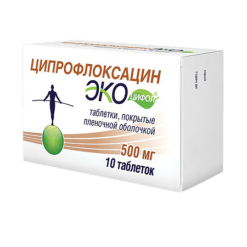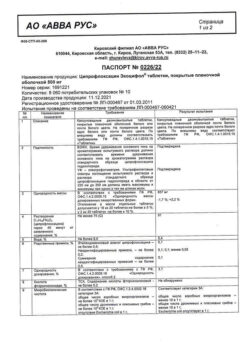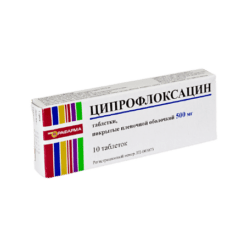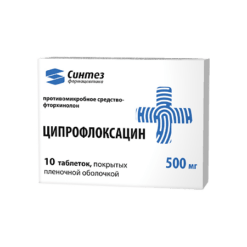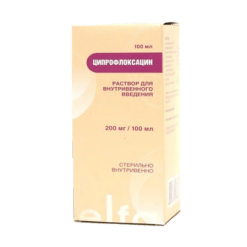No products in the cart.
Ciprofloxacin, 2 mg/ml 100 ml
€1.00
Out of stock
(E-mail when Stock is available)
Description
Ciprofloxacin is an antimicrobial, broad-spectrum antibacterial, bactericidal.
Pharmacokinetics
Infusion solution
After intravenous infusions of 200 mg or 400 mg, the TCmax is 60 minutes, Cmax is 2.1 µg/ml and 4.6 µg/ml, respectively. Vd – 2-3 l/kg, binding to plasma proteins – 20-40%.
It is well distributed in body tissues (excluding fat-rich tissue, such as nerve tissue). Content in tissues is 2-12 times higher than in plasma. Therapeutic concentrations are achieved in saliva, tonsils, liver, gallbladder, bile, intestines, abdominal and pelvic organs, uterus, seminal fluid, prostatic tissue, endometrium, fallopian tubes and ovaries, kidneys and urinary tract, lung tissue, bronchial secretion, bone tissue, muscles, synovial fluid and joint cartilage, peritoneal fluid, skin. It penetrates into the cerebrospinal fluid in small amounts, where its concentration in uninflamed cerebral membranes is 6-10% of that in blood serum, and in inflamed ones – 14-37%.
Ciprofloxacin also penetrates well into the ocular fluid, bronchial secretion, pleura, peritoneum, lymph, and through the placenta. The concentration of ciprofloxacin in blood neutrophils is 2-7 times higher than in serum. Activity decreases slightly at acidic pH values.
It is metabolized in the liver (15-30%) with formation of slightly active metabolites (diethylcyclofloxacin, sulfociprofloxacin, oxociprofloxacin, formylciprofloxacin).
In intravenous administration T1/2 is 5-6 hours; in chronic renal failure it is up to 12 hours. It is eliminated mainly by the kidneys by tubular filtration and tubule secretion unchanged (when administered intravenously – 50-70%) and as metabolites (when administered intravenously – 10%), the remaining part – through the gastrointestinal tract.
A small amount is excreted with the breast milk. After intravenous administration the concentration in urine during the first 2 hours after administration is almost 100 times higher than in serum, which significantly exceeds MPC for most pathogens of urinary tract infections.
Renal clearance is 3-5 ml/min/kg; total clearance is 8-10 ml/min/kg.
In chronic renal insufficiency (CKD more than 20 ml/min) percentage of drug excretion through the kidneys is decreased, but there is no cumulation in the body due to compensatory increase of drug metabolism and excretion in the feces. Patients with severe renal insufficiency (CKR less than 20 ml/min/1.73 sq.m) should administer half of daily dose.
Indications
Indications
Infectious and inflammatory diseases caused by microorganisms sensitive to Ciprofloxacin:
Active ingredient
Active ingredient
Composition
Composition
Active substance:
Ciprofloxacin hydrochloride monohydrate (in terms of ciprofloxacin) – 2.0 mg.
Auxiliary substances:
Sodium chloride – 9.0 mg,
Dinatrium edetate dihydrate (diatrium salt of ethylenediaminetetraacetic acid, trilon B) – 0.10 mg,
Lactic acid (in terms of 100% substance) – 0.64 mg,
water for injection – up to 1 ml.
How to take, the dosage
How to take, the dosage
The drug should be administered by intravenous drip for 30 minutes (200 mg dose) and 60 minutes (400 mg dose).
The infusion solution can be combined with 0.9% sodium chloride solution, Ringer’s solution, 5% and 10% dextrose (glucose) solution, 10% fructose solution, a solution containing 5% dextrose solution with 0.225% or 0.45% sodium chloride solution.
The single dose is 200 mg, in severe infections – 400 mg. Frequency of administration is 2 times a day; duration of treatment is 1-2 weeks; if necessary, it is possible to increase the course of treatment.
In acute gonorrhea the drug is administered intravenously once in a dose of 1000 mg.
For prevention of postoperative infections it is administered 30-60 minutes before surgery intravenously in a dose of 200-400 mg.
Patients with severe renal insufficiency (CKD should be administered half of the daily dose.
Interaction
Interaction
Due to the decrease of microsomal oxidation processes in hepatocytes, ciprofloxacin increases the concentration and prolongs the half-life of theophylline and other xanthines (e.g., caffeine), oral hypoglycemic drugs, indirect anticoagulants, reduces the prothrombin index.
When concomitant use with NSAIDs (except for acetylsalicylic acid) the risk of seizures increases.
Metoclopramide accelerates absorption of ciprofloxacin, which leads to decreased time of reaching maximum concentration of the latter.
The co-administration of uricosuric drugs leads to delayed excretion (up to 50%) and increased plasma concentration of ciprofloxacin.
When combined with other antimicrobial agents (beta-lactam antibiotics, aminoglycosides, clindamycin, metronidazole) synergism is usually observed. Therefore, Ciprofloxacin can be successfully used in combination with azlocillin and ceftazidime in infections caused by Pseudomonas spp.; with meslocillin, azlocillin and other beta-lactam antibiotics in streptococcal infections; with isoxazolpenicillins and vancomycin in staphylococcal infections; with metronidazole and clindamycin in anaerobic infections.
Cyprofloxacin increases nephrotoxic effects of cyclosporine; there is also increase of serum creatinine; therefore, in these patients it is necessary to control this index twice a week.
Cyprofloxacin increases the effect of indirect anticoagulants when taken concomitantly.
Pharmaceutical interactions
The infusion solution of the drug is pharmaceutically incompatible with all infusion solutions and drugs that are physicochemically unstable in an acidic environment (pH of ciprofloxacin infusion solution is 3.5-4.6). The solution for intravenous injection should not be mixed with solutions having pH more than 7.
Special Instructions
Special Instructions
If severe and prolonged diarrhea occurs during or after treatment with Ciprofloxacin, the diagnosis of pseudomembranous colitis should be excluded, which requires immediate withdrawal of the drug and appropriate treatment.
During treatment with Ciprofloxacin, sufficient fluids should be provided while maintaining normal diuresis.
Contact with direct sunlight should be avoided during treatment with Ciprofloxacin.
Patients with history of epilepsy, seizures, vascular diseases and organic brain lesions due to the risk of CNS adverse reactions Ciprofloxacin should be administered only with vital signs.
In case of severe and prolonged diarrhea during or after treatment with Ciprofloxacin the diagnosis of pseudomembranous colitis should be excluded which requires immediate drug withdrawal and appropriate treatment.
In case of tendon pain or if first signs of tendovaginitis appear the treatment should be stopped due to the fact that some cases of inflammation and even tendon rupture are described with fluoroquinolones.
Impact on driving and operating machinery
Patients taking Ciprofloxacin should be careful when driving and engaging in other potentially dangerous activities requiring increased attention and rapid psychomotor reactions (especially if alcohol is also used).
Contraindications
Contraindications
Side effects
Side effects
Digestive system disorders: nausea, diarrhea, vomiting, abdominal pain, flatulence, anorexia, cholestatic jaundice (especially in patients with past liver disease), hepatitis, hepatonecrosis.
CNS and peripheral nervous system disorders: Dizziness, headache, increased fatigue, anxiety, tremor, insomnia, “nightmare” dreams, peripheral paralgesia (abnormal perception of pain sense), sweating, increased intracranial pressure, anxiety, confusion, depression, hallucinations, manifestations of psychotic reactions (sometimes progressing to states in which the patient can harm himself), migraine, fainting, cerebral artery thrombosis.
Sense organs: disorders of taste and smell, visual disturbances (diplopia, altered color perception), tinnitus, decreased hearing.
Cardiovascular system disorders: tachycardia, heart rhythm disorders, decreased blood pressure, flushes to the skin of the face.
Hematopoietic system disorders: leukopenia, granulocytopenia, anemia, thrombocytopenia, leukocytosis, thrombocytosis, hemolytic anemia.
In laboratory parameters: hypoprothrombinemia, increased liver transaminases and alkaline phosphatase activity, hypercreatininemia, hyperbilirubinemia, hyperglycemia.
Urinary system disorders: hematuria, crystalluria (especially in alkaline urine and low diuresis), glomerulonephritis, dysuria, polyuria, urinary retention, albuminuria, urethral bleeding, hematuria, reduced renal nitrogen excretion function, interstitial nephritis.
Muscular system disorders: arthralgia, arthritis, tendovaginitis, tendon tears, myalgia.
Allergic reactions: Itching of the skin, urticaria, formation of blisters accompanied by bleeding, papules forming scabs, drug fever, petechiae (petechiae), facial or laryngeal edema, shortness of breath, eosinophilia, increased photosensitivity, vasculitis, nodular erythema, exudative erythema multiforme, Stevens-Johnson syndrome, toxic epidermal necrolysis (Lyell syndrome).
Other: arthralgia, arthritis, tendovaginitis, tendon tears, general weakness, myalgia, superinfections (candidiasis, pseudomembranous colitis), pain and burning at the injection site, phlebitis.
Overdose
Overdose
Treatment: no specific antidote is known.
The patient’s condition should be monitored carefully, gastric lavage should be performed, the usual first aid measures should be carried out, and adequate fluid intake should be ensured.
Only a small (less than 10%) amount of the drug may be eliminated by hemo- or peritoneal dialysis.
Pregnancy use
Pregnancy use
Ciprofloxacin is contraindicated in pregnancy and during lactation (breastfeeding).
Similarities
Similarities
Additional information
| Conditions of storage | Store in the dark place at 5 ° to 20 ° C out of the reach of children |
|---|---|
| Manufacturer | Sintez OAO, Russia |
| Medication form | solution for infusion |
| Brand | Sintez OAO |
Other forms…
Related products
Buy Ciprofloxacin, 2 mg/ml 100 ml with delivery to USA, UK, Europe and over 120 other countries.



